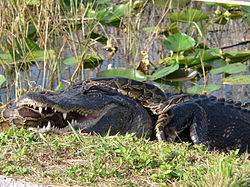Invasive species in the Everglades are exotic plants and animals that are not native to the area and have aggressively adapted to conditions in wilderness areas in southern Florida. The Everglades are a massive watershed in the southern portion of the U.S. state of Florida that drains overflow from the vast shallow Lake Okeechobee that is in turn fed by the Kissimmee River. The overflow forms a very shallow river about 60 miles (100 km) wide and 100 miles (160 km) long that travels about half a mile per day. The network of ecosystems created by the Everglades are surrounded by urban areas to the east in the South Florida metropolitan area, to the west by Naples and Fort Myers, and to the south by Florida Bay, a marine environment that receives fresh water from and is maintained by the Everglades. As it is surrounded on three sides and close to a major transportation and shipping center, it is particularly vulnerable to the importation of exotic species.
In the 20th century, Florida experienced a population surge unparalleled in the U.S., accompanied by rapid urban expansion made possible by draining portions of the Everglades. Flood control became a priority and the Central & South Florida Flood Control Project, from 1947 to 1971, constructed over 1,400 miles (2,300 km) of canals and flood control structures in South Florida. The widespread building created new habitats and disturbed established plant and animal communities. Many of the new residents or tourists in Florida were responsible for introducing plant species to the area by accident, or deliberately to improve landscaping. Many animals have been introduced similarly, and have either escaped or been released to proliferate on their own. Several terms are used to identify non-native species: exotic, invader, immigrant, colonist, introduced, nonindigenous, and naturalized. "Naturalized" usually refers to species that have adapted to a region over a long period of time,[1] while "invasive" refers to particularly destructive or aggressive species.[2]
Approximately 26 percent of all fish, reptiles, birds, and mammals in South Florida are exotic—more than in any other part of the United States—and the region hosts one of the highest numbers of exotic plant species in the world.[3][4] Many of the biological controls like weather, disease, and consumers that naturally limit plants in their native environments do not exist in the Everglades, causing many to grow larger and multiply far beyond their average numbers in their native habitats. Similarly, animals often do not find the predators or natural barriers to reproduction in the Everglades as they do where they originated, thus they often reproduce more quickly and efficiently. Concerns over the quality of the Everglades were raised in the beginning of the 20th century, and by 2000 a federally funded initiative was enacted that gave Everglades restoration the distinction of being the largest planned environmental rehabilitation in history. Exotic species control falls under the management of the U.S. Fish and Wildlife Service, which has been compiling and disseminating information about invasive species since 1994. Control of invasive species costs $500 million a year, but 1,700,000 acres (6,900 km2) of land in South Florida remains infested.[5]
- ^ Simberloff, et al, p. 5, 22.
- ^ Cite error: The named reference
lodge237was invoked but never defined (see the help page). - ^ Ferriter, et al (2004), p. 1.
- ^ Tommy Rodriguez (December 6, 2011). Visions of the Everglades: History Ecology Preservation. AuthorHouse. p. 110. ISBN 978-1-4685-0748-5.
- ^ Florida Invaders, National Park Service and Florida Fish and Wildlife Conservation Commission. Retrieved on February 3, 2010.

